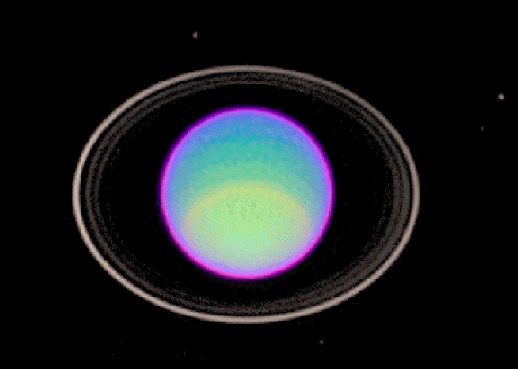Astronomy Picture of the Day
Discover the cosmos!
Each day a different image or photograph of our fascinating universe is
featured, along with a brief explanation written by a professional
astronomer.
April 30, 1996

Uranus' Ring System
Credit:
Erich Karkoschka (University of
Arizona Lunar & Planetary Lab) and
NASA
Explanation:
The rings of
Uranus
are thin, narrow, and dark compared to other planetary
ring systems. Brightened artificially by computer, the ring particles
reflect as little light as charcoal, although they are really made of ice
chucks darkened by rock.
This false-colour,
infrared picture from the
Hubble Space Telescope taken in
July 1995 shows the rings in conjunction to the planet. The
infrared
light allows one to see detail in different layers of
Uranus' atmosphere,
which has been digitally enhanced with false colour.
Three other planets in our
Solar System are known to have rings:
Jupiter,
Saturn, and
Neptune.
Four of
Uranus' moons are visible outside the ring plane. The
rings of
Uranus were discovered from ground-based observations
in 1977.
Tomorrow's picture: Comet Hyakutake and a Cactus
<
Archive
| Index
| Search
| Calendar
| Glossary
| Education
| About APOD
>
Authors & editors:
Robert Nemiroff
(MTU) &
Jerry
Bonnell (USRA)
NASA Technical Rep.:
Jay Norris.
Specific rights apply.
A service of:
LHEA
at
NASA/
GSFC
&:
Michigan Tech. U.
